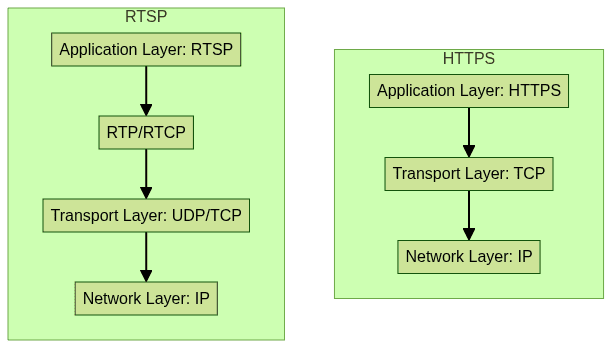Introduction to HTTPS and RTSP Protocols
In today's interconnected world, the choice of network protocol is fundamental to the success of any digital application, especially when it comes to secure communications and real-time media delivery. Two of the most widely-discussed protocols are HTTPS (Hypertext Transfer Protocol Secure) and RTSP (Real Time Streaming Protocol). Each serves distinct purposes within the landscape of internet communications. HTTPS is synonymous with secure web browsing, while RTSP powers real-time streaming scenarios, such as video surveillance and live media broadcasts. Understanding the differences between HTTPS and RTSP is critical for developers, architects, and system integrators tasked with building secure, performant, and scalable applications in 2025.
Understanding HTTPS Protocol
What is HTTPS?
HTTPS (Hypertext Transfer Protocol Secure) is an extension of HTTP that adds a security layer using SSL/TLS encryption. It ensures confidentiality, integrity, and authentication of data exchanged between a client and a server. As the de facto protocol for secure web communication, HTTPS safeguards sensitive transactions, such as online banking, e-commerce, and API interactions, from eavesdropping and man-in-the-middle attacks. For developers building secure communications into their apps, leveraging a
Video Calling API
can simplify the integration of encrypted real-time video and audio features.How HTTPS Works
HTTPS operates by establishing a secure connection over TCP, utilizing TLS/SSL for encryption. When a client (like a browser) initiates a connection to an HTTPS server, a handshake process negotiates cryptographic keys and verifies server authenticity. Once established, all subsequent data is encrypted.
Here's a simple example of an HTTPS request using Python's
requests library:1import requests
2response = requests.get(\"https://example.com/api/data\")
3print(response.text)
4This code sends an encrypted GET request, ensuring data privacy between the client and server.
Key Features and Use Cases for HTTPS
- Security: Encrypts data in transit to prevent interception.
- Authentication: Validates server identity via digital certificates.
- Integrity: Detects data tampering through cryptographic hashes.
- Use Cases: Web applications, RESTful APIs, e-commerce sites, secure file transfers, and any context requiring private, authenticated data exchange. For those working with cross-platform real-time communication, exploring
flutter webrtc
can be valuable for building secure video and audio experiences.
Understanding RTSP Protocol
What is RTSP?
RTSP (Real Time Streaming Protocol) is a network protocol designed for controlling streaming media servers. It establishes and manages sessions between endpoints to deliver real-time audio and video content. RTSP is commonly used in IP cameras, video surveillance, and live broadcasting, where low latency and fine-grained media control are required. Developers targeting mobile platforms may also consider solutions like
webrtc android
for real-time streaming and communication on Android devices.How RTSP Works
RTSP controls the setup, play, pause, and teardown of streaming sessions. It does not transport the media data itself; instead, it manages the connection, while actual media is typically delivered over RTP (Real-time Transport Protocol) using UDP or TCP.

Key Features and Use Cases for RTSP
- Real-Time Streaming: Designed for low-latency media delivery.
- Media Control: Supports play, pause, and seek operations during streaming.
- Use Cases: Video surveillance (CCTV), live broadcasting, remote monitoring, video conferencing, and any scenario where real-time interaction with media streams is essential. If you want to quickly add video calling features to your app, you can
embed video calling sdk
solutions for seamless integration.
HTTPS Protocol vs RTSP Protocol: Feature Comparison
Protocol Stack and Transmission Differences
HTTPS is layered over HTTP and TCP, leveraging TLS/SSL for secure transmission. It is optimized for reliability and security but not for real-time performance. Conversely, RTSP operates at the application layer, managing sessions and media control. The actual audio/video payload is transmitted using RTP, which can utilize either UDP (for low latency) or TCP (for reliability).

- HTTPS: Ensures reliable, ordered, and secure delivery; not optimized for continuous or
live streaming
. - RTSP: Designed for real-time media control, allowing low-latency streaming and interactive media sessions. For developers building browser-based solutions, a
javascript video and audio calling sdk
can help implement real-time features over secure protocols.
Security and Encryption
Security is a fundamental distinction between HTTPS and RTSP. HTTPS encrypts all communication by default using TLS/SSL, ensuring data privacy and integrity. RTSP itself does not mandate encryption; however, secure variants like RTSPS (RTSP over TLS) exist but are less commonly implemented. Media streams managed by RTSP (via RTP) may be unencrypted unless explicitly secured, which can be a vulnerability in surveillance or sensitive environments.
- HTTPS: End-to-end encryption, certificate-based authentication, robust against eavesdropping.
- RTSP: Plain by default, optional security layers available (RTSPS, SRTP), but implementation is inconsistent across devices and platforms. If your use case involves interactive broadcasts, leveraging a
Live Streaming API SDK
can provide secure and scalable live video delivery.
Latency and Real-Time Performance
HTTPS is not optimized for real-time communication due to its reliance on TCP and its strict ordering, which introduces buffering and higher latency. In contrast, RTSP combined with RTP over UDP delivers minimal latency, making it suitable for live broadcasts and surveillance feeds where timing is critical. However, this comes at the cost of potential packet loss and no built-in retransmission unless TCP is used.
Practical Implementation: HTTPS vs RTSP
Typical Scenarios for HTTPS
HTTPS is the backbone of secure web communication. Common scenarios include:
- Web Servers: Secure delivery of HTML, CSS, JS, and media assets.
- APIs: Protecting data exchanged between frontends and backends, mobile apps, and third-party integrations. Integrating a
Video Calling API
can further enhance security and functionality for real-time communication in your applications. - Browser Communication: Ensuring privacy and integrity of user data, authentication flows, and payment transactions.
Typical Scenarios for RTSP
RTSP is pivotal in real-time audio/video streaming:
- IP Cameras: Surveillance systems stream live video to security monitoring stations.
- Live Broadcasts: Media servers deliver sporting events, concerts, or news in real-time.
- Video Conferencing: Enables interactive sessions requiring synchronized media delivery. For those looking to experiment with these features, you can
Try it for free
and see how easy it is to implement real-time video solutions.
Interoperability and Compatibility Considerations
- Browsers: HTTPS is universally supported across all browsers and platforms. RTSP, however, is not natively supported in most modern browsers due to security and plugin concerns. Workarounds involve using media servers or WebRTC gateways.
- Firewalls: HTTPS traffic flows smoothly through most firewalls and proxies on standard ports (443). RTSP and RTP may require additional configuration, as they often use high or dynamic ports and can be blocked by strict firewalls.
- CDNs: Content Delivery Networks efficiently cache and distribute HTTPS content globally. RTSP streaming is less compatible with CDNs, as streams are typically live and not cacheable.
- Mobile Devices: HTTPS is fully supported. RTSP support varies by device and OS, with third-party apps often required.
Choosing Between HTTPS and RTSP: Use Cases and Decision Guide
When architecting a solution, choosing the right protocol depends on specific requirements:
- Use HTTPS if:
- You need secure, reliable data transfer (websites, APIs).
- Your application is browser-based or integrates with CDNs.
- Security and privacy are top priorities.
- Use RTSP if:
- Real-time streaming and low latency are essential (live video, surveillance).
- You require interactive media control (play, pause, seek).
- Your endpoints can support RTSP sessions (IP cameras, media servers).
Decision Checklist:
| Requirement | HTTPS | RTSP |
|---|---|---|
| Secure, encrypted transfer | Yes | Optional |
| Real-time streaming | No | Yes |
| Browser compatibility | Yes | No |
| CDN compatibility | Yes | No |
| Media control (play/pause) | No | Yes |
| Works through firewalls | Yes | Sometimes |
Code Snippets and Example Configurations
Example: HTTPS Server Setup
Here's how to set up a basic HTTPS server in Node.js for secure web communications:
1const https = require(\"https\");
2const fs = require(\"fs\");
3
4const options = {
5 key: fs.readFileSync(\"server.key\"),
6 cert: fs.readFileSync(\"server.cert\")
7};
8
9https.createServer(options, (req, res) => {
10 res.writeHead(200);
11 res.end(\"Hello, HTTPS!\");
12}).listen(443);
13Example: RTSP Streaming Setup
Example using FFmpeg to stream a local video file over RTSP to a media server:
1ffmpeg -re -i input.mp4 -c:v libx264 -f rtsp rtsp://media-server.example.com/live/stream
2This command pushes the video file to an RTSP server, making it available for real-time streaming to compatible clients.
Conclusion
In summary, HTTPS and RTSP serve different but sometimes complementary roles in modern networked applications. HTTPS excels in secure, reliable data transmission and is universally supported across web technologies. RTSP specializes in real-time media streaming, offering low latency and fine control over media sessions. Choose HTTPS for web communication and secure APIs, and RTSP for real-time streaming scenarios such as surveillance and live broadcasting. Understanding their strengths and limitations ensures you deploy the right protocol for your application's needs in 2025.
Want to level-up your learning? Subscribe now
Subscribe to our newsletter for more tech based insights
FAQ